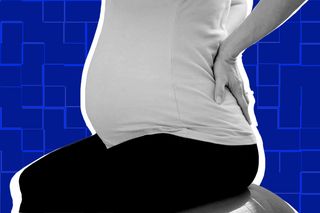
What To Do For Back Pain When You’re Pregnant
It’s tempting to rest, but working out will do more to ease the ache.

Back pain during pregnancy is experienced by up to 80% of mums-to-be. The good news is that the baby is growing; the bad news is that it often leaves pain and discomfort in the tailbone and lower back, but also potentially in the upper or middle back.
What causes back pain during pregnancy?
The magnitude or severity of the back pain during pregnancy varies amongst individuals. It’s influenced by weight gain, hormonal productions, postural factors or changes in the abdominal muscle. Independently, or combined, these factors can cause a backache during pregnancy.
On average, a pregnant woman will gain about 11-15kgs throughout the gestation period, and a majority of this weight is distributed around the abdomen. As the baby and belly grow, often burdening the spine, the back muscles work more, resulting in discomfort.
Hormonal production and changes can compound this discomfort. The production of the hormone relaxin—that helps prepare the pelvis for delivery by relaxing the pelvic ligaments and loosening the joints—increases. The lower back — i.e., the sacroiliac joint, which is attached to the pelvis — is therefore affected. This can makes you feel less stable, often causing pain when you walk, stand, sit, turn from side to side, bend, and lift.
However, postural changes and compensations impact the back the most. The growing belly during pregnancy results in the body’s center of gravity shifting forward, which can prompt a slight forward bend, rounded shoulders and a waddling gait. This stresses back muscles and can cause pain.
Ultimately, back muscles are the muscles compensating for many of the physiological stressors of pregnancy. This is especially true when other muscle systems are weak. For instance when the rectus abdominal muscles — the two parallel sheets of muscles running from the rib cage to the pelvis — begin to separate and weaken due to the expanding uterus, the back muscles become overworked just to keep you upright, worsening the back pain.
Upper, middle, lower – what is normal back pain during pregnancy?
While upper and middle back pain during pregnancy is possible, it typically won’t be a new problem — if you suffer from upper or mid-back pain before pregnancy, it’s possible that kind of backache will continue during pregnancy. But the physical changes of pregnancy don’t typically cause new pain in these areas.
Pregnancy can, however, cause posterior pelvic pain — that is, pain in your tailbone and the area around it. This is the most common type of back pain during pregnancy. It may be triggered by rolling in bed, climbing stairs, lifting, turning or even by simply walking or sitting for long. Very often, this tailbone pregnancy is accompanied by pain in the pubic bone (the bone at the front of your crotch).
Low back pain is also common and occurs in the lumbar vertebrae. It feels similar to a normal lower backache you might have experienced before you got pregnant. It often becomes more intense throughout the day, and could begin with seemingly no cause — while merely sitting or walking. The pain may radiate to the legs as well.
Sometimes, back pain during pregnancy is accompanied by leg pain that radiates into the buttocks, thigh and a little beyond the knee, or even pain in the ankle or foot. In these cases, you might experience tingling, numbness and the feeling of pins and needles as well. This is indicative of a herniated disc in the lower spine — when the sac of soft ‘jelly’ between two vertebrae, under excess pressure, bulges outward — which can compress the sciatic nerve, resulting in back and leg pain during pregnancy. This is a specific type of pain known as sciatica, and it requires treatment from a professional.
However, these types of back pain during pregnancy, and others, can be prevented or eased with exercise at home. (Though if symptoms persist even after regularly performing these exercises, see a professional.)
Exercise for back pain during pregnancy
While it may be enticing to rest the pain out, taking up a regular exercise regime is a better way to address back pain during pregnancy. Slow and controlled exercises to strengthen abdominal, back, pelvic floor, buttocks, thighs and leg muscles, combined with gentle stretching to increase flexibility and reduce stress in the same muscles, can also help in treating back pain in pregnancy effectively.
Pelvic tilts accomplish both stretching and strengthening, and are among the best exercises to ease tailbone and lower back pain. To do them, get on your hands and knees, arms shoulder-width apart and knees hip-width apart. Keep your arms straight, but don’t lock the elbows. Slowly round your back and tuck your buttocks under as you breathe in (breathing is important). Relax the back into a neutral position as you breathe out and repeat three to five times, twice a day.
Light cardiovascular activities like walking and swimming for 30-40 minutes, 4-5 times/week at a mild or moderate level proves to be extremely beneficial. For those experiencing intense back pain, begin with a 10-minutes walk post-meals and gradually look at increasing the time.
What else helps with back pain during pregnancy?
Postural and ergonomic changes can also help with back pain relief and prevention:
- Keep your back erect and correct any slouching posture.
- Use a foot stool and a small roll behind the lower back when seated, if needed.
- Get up and move every hour.
- Avoid extreme hip movements.
- Always bend from the knees with your spine erect when attempting to lift objects. Avoid twisting or bending with a hunched back.
- While carrying things, ensure you divide the load between both your sides. Do not carry all the weight on one side.
- Use a pillow or wedge between your thighs while sleeping. Add another pillow below the abdomen to support the growing belly, if needed, and use a firm mattress to sleep.
Vanshika Gupta Adukia is a Mumbai-based physiotherapist who specializes in antenatal, postnatal and pelvic floor care, a childbirth educator, and the founder of Therhappy. She holds a Bachelor of Physical Therapy degree from DY Patil University, Mumbai, and is a CAPPA Certified Lactation Educator. An avid reader, she is passionate about women's health, little babies, all things colorful and happiness.
Related


Babies Can Tell the Difference Between Bullies and Leaders
